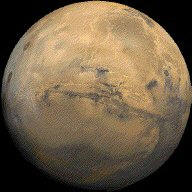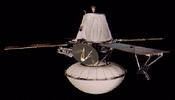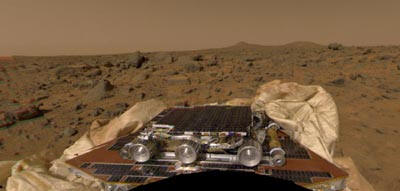
Mars

Mars is the fourth planet from the Sun. It is the first of the 'superior' planets, indicating that its orbit is further from the Sun than that of the Earth's. It has two very small moons, Phobos and Deimos. Like Earth, Venus, and Mercury, Mars is a rocky planet, but is relatively small, being between Mercury and Venus in size. It has many striking surface features, such as Olympus Mons, a giant volcano, three times the height of Everest, and with a base 600km in diameter. An extensive valley complex, named Valles Marineris, can be followed for a total length of over 4,500km, and, in places, descends to 7km below the rim.
Atmosphere The Martian atmosphere is composed mainly of carbon dioxide (95%), with the rest being made up from nitrogen and argon. The surface pressure is very low at around 10 mbar (200Pa), due to the lack of depth of atmosphere. Under these conditions, liquid water cannot exist on the planet's surface. However, there is plenty of H2O on Mars, locked up for example in the polar caps, and probably underground. The range of temperatures experienced on the planet's surface is very wide. Away from the equator, maximum daytime temperatures reach only -30 degC, while, on the equator, this can rise to over 22 degC. The thin atmosphere is a poor heat retainer, and night-time temperatures fall to around -100 degC in even the warmest of places.
The wide range of temperatures are the cause of extremely high winds across the planet, producing fearsome dust storms which can be seen with telescopes from the Earth. Coupled with seasonal changes at the poles, the surface appearance is constantly changing.
Martian Explorers The first accurate information gained about the planet came from the American Mariner missions conducted during the 1960s and culminating in the Mariner 9 launch in 1971. Viking 1 and 2 were to land on the planet in 1976 and provided the first views from the planet surface.


Many recent missions by both the USA and Russia have been unsuccesful
Relentless Pursuit In 1997, NASA began an intensive campaign of exploration of the planet, starting with the Pathfinder lander. The rover, called Sojourner (below) underwent a controlled crash landing! In the picture, you can see the now-deflated air bags that cushioned its landing!

A total of eight missions are planned or under way. In late 1997, an Orbiter arrived to map the surface in intricate detail. In 1999, the Climate Orbiter will arrive to study its climate and surface. In the same year, the Polar Lander will arrive. On-board are two small microprobes (Deep Space 2) which will penetrate into the surface to detect water ice. All the scientific missions being conducted will ultimately lead to the first manned flights to the red planet, the forerunner to the setting up of permanent bases on its surface.
A Rocky Return NASA intends returning samples of Martian rock as soon as practicable. However, we already have over a dozen samples of rocks from Mars that have come crashing to the Earth as meteorites!
This includes the rock found in the Artic, that was first suspected of harbouring the first evidence of life, other than on Earth.